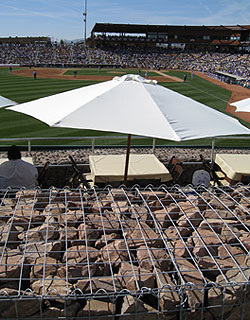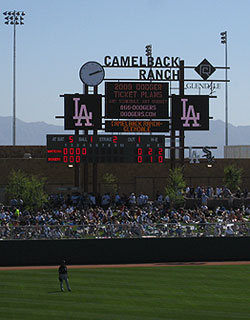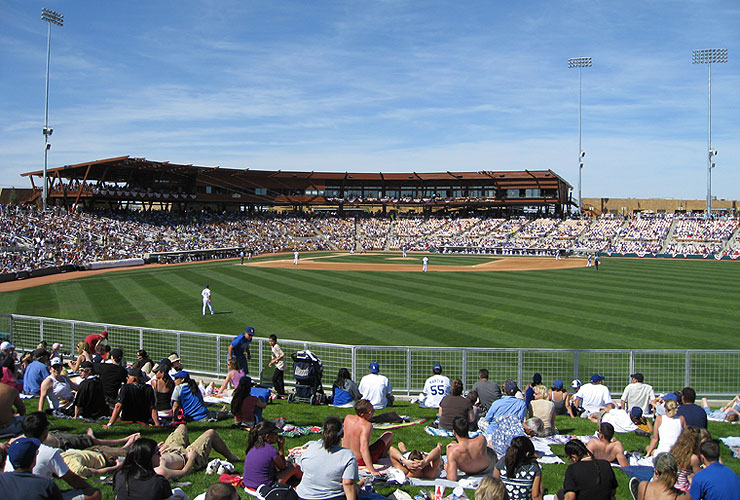
|
When it comes to spring training ballparks, state-of-the-art has a new name: Camelback Ranch.
Perhaps the most unique ballpark to open since Camden Yards (yes, it's that transcendent), Camelback Ranch officially began to wow fans on March 1, 2009 when its two tenants, the Chicago White Sox and Los Angeles Dodgers, played the inaugural game at the $100 million complex named after the property it was built on. From the moment they arrive on its premises, fans will notice there’s something special about Camelback Ranch. Parking lots are to the south and west of the stadium and each has walking paths that lead to its main entrance in center field. Made of decomposed granite, the trails are integrated into the complex so that fans walk alongside the practice fields. That accessible design encourages the intimacy that has so long been the enduring appeal of spring training. The trails give Camelback Ranch the feel of a park and that feeling is further enhanced by a two-acre lake that runs down the middle of the 141-acre complex. The curvaceous lake is 1,300 feet long and does more then just enhance the aesthetic beauty of the grounds, which were planted with 5,000 trees and plants, as it provides irrigation for the ball fields and landscaping. The lake is stocked with fish for aquatic plant control. An army of 6,000 small carp patrolled the waters after the initial stocking. The lake also serves as a barrier between the two sides of the complex, separating the White Sox’s practice fields and clubhouses from the Dodgers’ facilities. Each team has use of six full-sized fields. The White Sox portion of the complex makes up the western half, while the Dodgers’ eastern half also includes an orange grove. Amphitheatre-style stone benches are placed behind the backstops of some practice fields. Fans arriving at the center field entrance pavilion are often greeted by live music, which is performed from a waterside bandstand near the ticket office.
Seats are all caramel in color, but only those in the swanky Home Plate Club have cup holders. Between the berm and symmetrical grandstand, up to 13,000 fans encircle the ballpark. An open concourse likewise encircles the playing field and the grandstand is big enough that it contains an additional concourse below its mid-point. The playing field is sunken 12 feet below grade while the grandstand is elevated 12 feet above grade. That explains why the outfield berm is at a lower elevation than the grandstand. Bullpens are adjacent to the foul poles and feature party patios above them. When the White Sox play at home their relievers man the bullpen in right, which is more fan accessible than the Dodgers ‘pen in left, as the berm extends behind the right field bullpen but not the left. Drink rails are set up on the concourse in left field. Recycling canisters shaped like plastic bottles are easy for environmentally conscious fans to find on all portions of the concourse. In addition to the bevy of concessionaries and ATMs found on the concourse, the New Era Cap Corner in right field carries hats of all teams in the Cactus League. Larger souvenir shops are found behind both home plate and center field.
The skyline is composed of two distinct objects. The South Mountains make up a nice backdrop for fans sitting on the third base side of the stadium. Glimpses of Glendale’s domed football stadium can be had from portions of the first base grandstand. Naming rights to the football stadium, home of the Arizona Cardinals and Fiesta Bowl, were bought by the University of Phoenix, which didn’t please Glendale city officials. So the city insisted that their name be on the ballpark, hence its official designation as Camelback Ranch-Glendale. In an ironic twist, the ballpark is actually located in Phoenix, but on land owned by Glendale. And much to the city’s chagrin, it’s generally referred to as simply Camelback Ranch. No ballpark is perfect and Camelback Ranch certainly is not. But its biggest flaw is not in its design but rather its orientation, which ensures shade is almost nonexistent during afternoon games. That's because the ballpark was built to face the southeast, and hence the sun. As such, sunscreen is as necessary for fans in the stands as protective equipment is for catchers behind home plate. Even fans in the high-end Home Plate Club can't escape the sun from their premium padded seats, which made news with their initial $90 per seat price tag. But included in that cost of admission is complimentary water and sunscreen. Regular fans who forget to bring theirs can pick up a mini bottle of Coppertone at the gift shop; otherwise it will look like they spent the day at a tanning solon rather than a ballpark. Although the lack of shade is a problem that can’t be easily corrected, a screen was erected in center field to fix one that could. The original plan at Camelback Ranch was to use Afghan pines as the hitter’s backdrop, but when players complained that the trees weren’t dense enough to block out all sunlight the traditional hitter’s background – the green screen – was placed in front of them. Touted as a campus rather than a complex and a park rather than a facility, Camelback Ranch is as unique as the famed Dodgertown complex in Vero Beach that it drew much of its inspiration from. "It will be the Taj Majal of Spring Training facilities," Dodgers Assistant GM De Jon Watson said before it opened. And aside from an overabundance of sunlight, the impressive Camelback Ranch lives up to that gaudy advance billing.
Location and ParkingThe ballpark is less than two miles west of Loop 101, from which signs lead fans to the "Glendale Baseball Complex" and Camelback Road (exit #5). The entire Camelback Ranch complex is between the intersections 107th Avenue and 111th Avenue (aka Ballpark Boulevard), and across the street from the KB Home Camelback Ranch development. Just to the northwest of the ballpark is the Glendale Municipal Airport, where small aircraft land and take off with regular frequency. Beyond the airport, wide open spaces and a rock quarry are all that is to the west of the ballpark, while commercial development is springing up between it and Loop 101, guaranteeing the area remains a construction zone for years to come. The buildings already completed are done in earth-tone colors that match the surrounding desert landscape. Plenty of parking (5,000 spaces) is available within the complex at one of two unpaved lots. The entrances for each contribute to traffic getting backed up on Camelback Road. Season ticket holders and VIPs have to wait in that traffic too, but they get to park in the paved lot behind home plate rather than the dirt fields with chalk marks used to designate spaces for everyone else.
Ballpark Construction and HistoryGroundbreaking ceremonies for the new Glendale Spring Training Complex, originally priced at $80.7 million, took place on November 19, 2007, and 15 months later a 10,000-seat ballpark stood on previously barren desert land. The entire complex was built on 141 acres of land within the city limits of Phoenix that is actually owned by Glendale, a West Valley suburb that is home to both the Arizona Cardinals of the NFL and Phoenix Coyotes of the NHL. The two-team complex added two Major League franchises to the city's sports portfolio. The Los Angeles Dodgers were lured away from their famed Dodgertown complex in Florida, finally bringing the team’s preseason operations to the West Coast. The Dodgers had been the last remaining West Coast team to train in Florida, a holdover from their Brooklyn days. Although the team left many memories behind in Vero Beach, they did bring some trees from their spring home of 61 years to Arizona, planting them in the orange grove found on their half of the complex. An iron clad lease with Pima County to keep the Chicago White Sox training in Tucson through 2012 didn't keep them from relocating to Glendale. White Sox owner Jerry Reinsdorf steadily maintained that his team would be training and playing in Glendale in 2009, which only could've happened if his organization was able to find another team to take over the Sox’s lease at Tucson Electric Park. They couldn't and offered to buy out the remains of their lease. On November 18, 2008 the Pima County Board of Supervisors voted unanimously (5-0) to accept the White Sox's $5 million buyout offer of their lease at Tucson Electric Park. That decision enabled the team to move to Glendale but probably will lead to the Cactus League's exodus from Tucson. Tucson was reluctant to let the Sox go but did anyway, knowing full well the city could lose Spring Training altogether if fewer than three teams train there. That's now the case as only the Diamondbacks and Rockies remain. Both of those teams are now looking to follow the White Sox's lead and would exercise the out clauses in their leases if they had a new ballpark to move to in the Phoenix Valley. Without the cooperation between Glendale and Phoenix the dilemma in Tucson would not have been possible. Although the ballpark and complex carries Glendale’s name, it was actually built on land in Phoenix so the two cities had to agree on a tax-revenue sharing plan before construction could begin. HKS Architects, the firm that produced the Rangers Ballpark in Texas and Miller Park in Milwaukee, was responsible for the design of the Glendale ballpark, which in the years to come will be surrounded by restaurant and retail development, a four-star hotel and an 18-hole golf course. Two-thirds of the funding for the complex, which ended up costing $100 million, came from the state-run Arizona Sports and Tourism Authority. The city of Glendale was responsible for the remaining one-third and expects to generate its funding with sales taxes and other revenues from the 500 acres that will be developed near the ballpark, which was simply referred to as Glendale Ballpark during most of its construction. On November 20, 2008 the Dodgers and White Sox jointly announced that their spring training complex would be called Camelback Ranch. That name was chosen because the property it resides on had long been called Camelback Ranch, although a ranch never existed on its grounds. Prior to sprouting a baseball stadium the land was farmed, most notably for Brussels sprouts and broccoli.
Camelback Ranch Footnotes
| |||||||||||||||||||||||||||||||||||||||||||||||||||||||||||||||||||||||||||||||||||||||||||||||||||||||||||||||||||||||||||||||||||||||||||||||||||||||||||||||||||||||||||||||||||||||||||||||||||||||||||||


 Inside and out, the ballpark was designed to fit in with its natural surroundings. Real stone veneer was used to construct many buildings in the complex. Facades of all buildings are painted a shade of brown, with three tone faux painting enhancing the permanent concession stands. Interior retaining walls are made of wire mesh filled with stones, an eye-catching entrapment known in the architectural world as Gabion walls.
Inside and out, the ballpark was designed to fit in with its natural surroundings. Real stone veneer was used to construct many buildings in the complex. Facades of all buildings are painted a shade of brown, with three tone faux painting enhancing the permanent concession stands. Interior retaining walls are made of wire mesh filled with stones, an eye-catching entrapment known in the architectural world as Gabion walls.
 The stadium’s sole scoreboard is behind the berm in right-center and is as sleek in appearance as the clubhouses behind opposite sides of the outfield.
The stadium’s sole scoreboard is behind the berm in right-center and is as sleek in appearance as the clubhouses behind opposite sides of the outfield.


